Petroleum Jelly… TikTok loves it. Do we?
Is it safe? Is it effective? Is it really not pore-clogging? Are you wasting money on skincare when you could just use Vaseline? We dig in!
If your TikTok highlights skin care, then you have definitely seen the holy grail drugstore product, petroleum jelly. Vaseline is one of the most popular brand names for petroleum jelly, but Aquaphor and CeraVe have similar options as well (we’ll dive into the differences later).
What is petroleum jelly? Petroleum jelly (AKA petrolatum) is an extremely common skincare ingredient derived from you guessed it… petroleum or crude oil. It has a melting point similar to our body temperature, so when you apply it to the skin, it softens and forms a film. This film keeps moisture in and keeps bacteria out.
Can and should you use petroleum jelly daily?
I mean, it’s so cheap and apparently magical – so it should be your go-to skincare product, right? Well, not exactly. If you are prone to chapped skin, eczema, or other reactions, then it should be a staple for you. It’s great for recovering from deep skin treatments, traveling, and protecting your skin from PPE, intense cold weather, and chlorine. However, if your skin is not chapped, then there’s really no reason to cover it in Vaseline (AKA slugging) regularly. If you put an abundance of occlusive ingredients on your skin you may affect the skin's ability to moisturize, heal, and protect itself. Plus, your pillowcase will get really greasy!
Slugging creates the illusion of glowing skin because petroleum jelly is so shiny, but there are better ways to get glowy skin from within. Petroleum jelly does not take the place of skincare because it won’t penetrate the skin with ingredients we want in there to nourish the skin. The skin needs layers of nourishment and hydration to really glow. Read more about how to hydrate your skin properly here!
Is it really non-comedogenic (AKA acne-safe)?
Yes, it is, as long as it’s used properly and in proper conditions. You will still want to look at ALL the ingredients in your preferred petroleum jelly product to make sure there are no hidden pore-cloggers present. Also, you don’t necessarily want to put it on over active acne, because you want to let your pores work to exfoliate out the impactions and heal.
Is petroleum jelly safe or non-toxic?
Yes. While petrolatum can contain harmful chemicals if not fully refined, it is now very refined. Some argue the European standards for refining petrolatum are higher. That may or may not be true. However, petrolatum is one of the few FDA-approved ingredients. And you will just have to trust that leading brands are refining it to high standards. White petrolatum is refined to the highest level, so if “clean” is important to you, try white petrolatum with no added ingredients or fragrance to avoid any possible endocrine disruptors there.
It’s easy to shame petroleum jelly because, after all, it is derived from petroleum – but there is no danger associated with it. Even EWG (one of the many popular fear-mongering “clean beauty” sites) gives it a 1-4 rating. Below we’ve included some similar non-petroleum products if you really want to avoid petrolatum.
So the bottom line?
Keep petroleum jelly handy for chapped skin. It’s also by far the best cure for chapped lips. Yes, it can save you money on spendy beauty balms and lip products, but it doesn’t replace your skincare serums or moisturizers. It’s acne-safe, but shouldn’t be put on active pimples and it won’t help clear your skin. And finally, it is, by our standards, non-toxic and (in our opinion) a lot safer than “natural” products full of untested ingredients. If you want to use the “safest” version possible, look for a brand that has no other ingredients than petrolatum itself.
Here is a little breakdown of the top petroleum and non-petroleum alternatives:
Vaseline / Generic Brands Petroleum Jelly: 100% petroleum jelly, this will be heavier and thicker than the others. This formulation has fewer ingredients which may appeal to some. Often used as a first-aid product.
Aquaphor: Less than half of the formulation is petroleum jelly and contains other skin-healing ingredients. This will be lighter and more user-friendly. Aquaphor contains glycerin to help hydrate skin as well.
CeraVe Healing Ointment: Similar to Aquaphor but also contains ceramides. Note that while this formulation is acne-safe, the other CeraVe moisturizers are not.
Rosebud Salve: Our favorite lip product that also contains additional ingredients to help nourish dry lips and give you a pretty pout.
Non-Petroleum
Vanicream Moisturizing Ointment: Hydrogenated polydecene is a mineral oil alternative that leaves a less greasy feel. Vanicream is free of fragrances, dyes, parabens, lanolin, and formaldehyde releasers. A great choice for eczema.
Alba Botanicals Un-Petroleum Jelly: A blend of oils and beeswax makes this the crunchiest of choices. Acne-friendly, but not as acne-safe as the other options.
